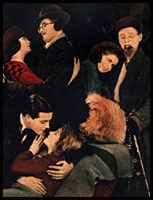
 |
Susanna Rowson's Charlotte Temple (1794) was not only one of America's first novels, it was America's first massively popular novel. Originally published without much fanfare in England in 1791, the American edition of 1794 was an immediate triumph. It has been through over 200 editions and still sells copies today, though now mostly to an academic, not a popular audience. Its impact on American culture has been steady and broad: for example, the novel became the basis for popular 19th century stage melodramas, which in turn served as the basis for a classic silent film, Way Down East, by the influential D.W. Griffith (the director of Birth of A Nation and Intolerance, a man widely acknowledged as the first great American film director), and starring Lillian Gish. It was then remade in 1935 by director Henry King, and starring Henry Fonda. (For more on Way Down East, see below.) |
As you're reading through Charlotte Temple for the first time, here are some things you might think about:
• How is this text different from -- or similar to
-- Michael Wigglesworth's jeremiad The Day of Doom?
• Where does the power of this story lie: in its
style? its plot? its characterizations? What elements
did you find moving, and why?
• In several places, the narrator addresses her
audience directly. What are the effects of these interruptions?
• Who would you say is the target audience for this
book?
• What is the importance of the backstory Mr. Eldridge
tells in chapters 3-4?
• What is the role of writing (or reading) in the
novel?
• For that matter, what's with all the crying?
What role do you think all those tears are playing?
• Were you surprised by the ending? Why or
why not?
• Who is the real villain of this novel, and why?
We've also asked you to read Cathy Davidson's article , "The Life and
Times of Charlotte Temple: The Biography of a Book." After you've
read it, you might try to do a "morphological" interpretation of our edition
of the book. Which "version" of Charlotte does our book (its cover,
title page, binding, etc.) present: Charlotte, daughter of poverty and
innocent victim of masculine deception? Charlotte, role model for
the young? Charlotte, sentimental heroine? Charlotte, seductress?
Or some other Charlotte altogether?
And for more on Way Down East:
Way Down East borrows not only from Charlotte Temple, but also, interestingly, in its climactic scene of Gish jumping from ice floe to ice floe, it also borrows from Uncle Tom's Cabin, the book that surpassed Charlotte Temple as the bestselling American novel of all time.
The plot summaries below are copied from various movie catalogues on
the internet which sell both versions of Way Down East.
 |
Way Down East (1920)
Synopsis: Based on a popular 19th century play, Way Down East is a poignant melodrama about a poor country girl (Lillian Gish) who is tricked into fake marriage and has an illegitimate child who dies. After starting a new life, her past is exposed and she is evicted into a raging blizzard, pursued by the young man who secretly loves her.
For a more detailed plot summary of the 1920 version, click
here.
Way Down East (1935)
A remake of the classic D.W. Griffith-Lillian Gish-Richard Barthelmess
silent of 1920,
WAY DOWN EAST here shows that its material is rather dated. Rochelle Hudson,
taking over
the lead role from Janet Gaynor (reportedly involved in a car accident,
but some say
there was a personal conflict), stars as the poor waif who wanders around
penniless
after being duped into a false marriage to the wealthy Trevor and having
a child by
him. The baby soon dies, Hudson is taken in by a farm family headed by
the puritanical
Simpson, and she falls in love with his son, Henry Fonda. Word of Hudson's
spotted past
eventually gets out, and she is banished from the farm. While trying to
cross a frozen
river, the ice breaks apart and she begins floating toward a waterfall.
Fonda, leaping
from ice floe to ice floe, saves Hudson and agrees to marry her. The final
climactic
scene, one of the most famous in silent cinema, still can raise one's heartbeat,
but
Hudson is nothing in comparison to Gish. As hokey as the film is, Fonda
delivers the
persona that has made him one of the screen's great actors--the film's
saving grace.
For more on this version, click
here.